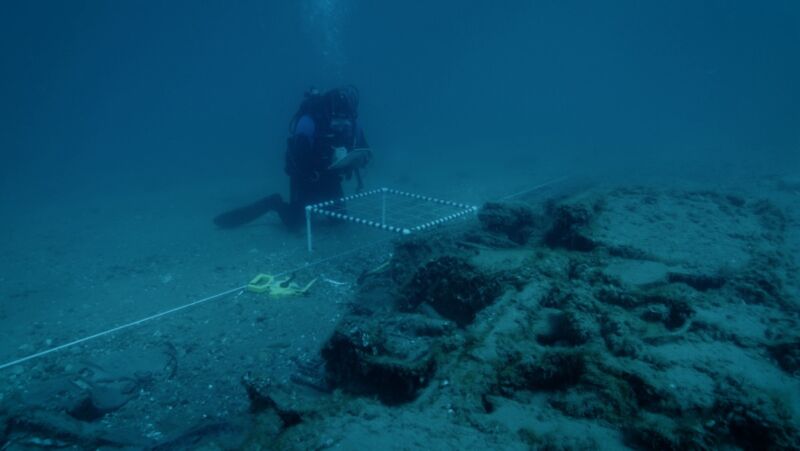Remembering a hero this Juneteenth —
The Real Red Tails investigates the fatal crash of 2nd Lt. Frank Moody in 1944.

Enlarge / Michigan’s State Maritime Archaeologist Wayne R. Lusardi takes notes underwater at the Lake Huron WWII wreckage of 2nd Lt. Frank Moody’s P-39 Airacobra. Moody, one of the famed Tuskagee Airmen, fatally crashed in 1944.
National Geographic
In April 1944, a pilot with the Tuskegee Airmen, Second Lieutenant Frank Moody, was on a routine training mission when his plane malfunctioned. Moody lost control of the aircraft and plunged to his death in the chilly waters of Lake Huron. His body was recovered two months later, but the airplane was left at the bottom of the lake—until now. Over the last few years, a team of divers working with the Tuskegee Airmen National Historical Museum in Detroit has been diligently recovering the various parts of Moody’s plane to determine what caused the pilot’s fatal crash.
That painstaking process is the centerpiece of The Real Red Tails, a new documentary from National Geographic narrated by Sheryl Lee Ralph (Abbot Elementary). The documentary features interviews with the underwater archaeologists working to recover the plane, as well as firsthand accounts from Moody’s fellow airmen and stunning underwater footage from the wreck itself.
The Tuskegee Airmen were the first Black military pilots in the US Armed Forces and helped pave the way for the desegregation of the military. The men painted the tails of their P-47 planes red, earning them the nickname the Red Tails. (They initially flew Bell P-39 Airacobras like Moody’s downed plane, and later flew P-51 Mustangs.) It was then-First Lady Eleanor Roosevelt who helped tip popular opinion in favor of the fledgling unit when she flew with the Airmen’s chief instructor, C. Alfred Anderson, in March 1941. The Airmen earned praise for their skill and bravery in combat during World War II, with members being awarded three Distinguished Unit Citations, 96 Distinguished Flying Crosses, 14 Bronze Stars, 60 Purple Hearts, and at least one Silver Star.
-
2nd Lt. Frank Moody’s official military portrait.
National Archives and Records Administration
-
Tuskegee Airman Lt. Col. (Ret.) Harry T. Stewart.
National Geographic/Rob Lyall
-
Stewart’s official portrait as a US Army Air Force pilot.
National Archives and Records Administration
-
Tuskegee Airman Lt. Col. (Ret.) James H. Harvey.
National Geographic/Rob Lyall
-
Harvey’s official portrait as a US Army Air Force pilot.
National Archives and Records Administration
-
Stewart and Harvey (second and third, l-r).
James Harvey
-
Stewart stands next to a restored WWII Mustang airplane at the Tuskegee Airmen National Museum in Detroit.
National Geographic/Rob Lyall
A father-and-son team, David and Drew Losinski, discovered the wreckage of Moody’s plane in 2014 during cleanup efforts for a sunken barge. They saw what looked like a car door lying on the lake bed that turned out to be a door from a WWII-era P-39. The red paint on the tail proved it had been flown by a “Red Tail” and it was eventually identified as Moody’s plane. The Losinskis then joined forces with Wayne Lusardi, Michigan’s state maritime archaeologist, to explore the remarkably well-preserved wreckage. More than 600 pieces have been recovered thus far, including the engine, the propeller, the gearbox, machine guns, and the main 37mm cannon.
Ars caught up with Lusardi to learn more about this fascinating ongoing project.
Ars Technica: The area where Moody’s plane was found is known as Shipwreck Alley. Why have there been so many wrecks—of both ships and airplanes—in that region?
Wayne Lusardi: Well, the Great Lakes are big, and if you haven’t been on them, people don’t really understand they’re literally inland seas. Consequently, there has been a lot of maritime commerce on the lakes for hundreds of years. Wherever there’s lots of ships, there’s usually lots of accidents. It’s just the way it goes. What we have in the Great Lakes, especially around some places in Michigan, are really bad navigation hazards: hidden reefs, rock piles that are just below the surface that are miles offshore and right near the shipping lanes, and they often catch ships. We have bad storms that crop up immediately. We have very chaotic seas. All of those combined to take out lots of historic vessels. In Michigan alone, there are about 1,500 shipwrecks; in the Great Lakes, maybe close to 10,000 or so.
One of the biggest causes of airplanes getting lost offshore here is fog. Especially before they had good navigation systems, pilots got lost in the fog and sometimes crashed into the lake or just went missing altogether. There are also thunderstorms, weather conditions that impact air flight here, and a lot of ice and snow storms.
Just like commercial shipping, the aviation heritage of the Great Lakes is extensive; a lot of the bigger cities on the Eastern Seaboard extend into the Great Lakes. It’s no surprise that they populated the waterfront, the shorelines first, and in the early part of the 20th century, started connecting them through aviation. The military included the Great Lakes in their training regimes because during World War I, the conditions that you would encounter in the Great Lakes, like flying over big bodies of water, or going into remote areas to strafe or to bomb, mimicked what pilots would see in the European theater during the first World War. When Selfridge Field near Detroit was developed by the Army Air Corps in 1917, it was the farthest northern military air base in the United States, and it trained pilots to fly in all-weather conditions to prepare them for Europe.